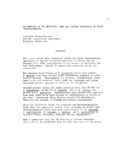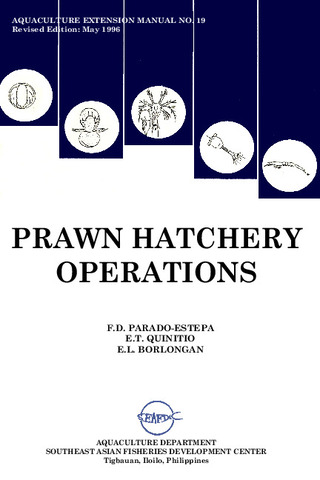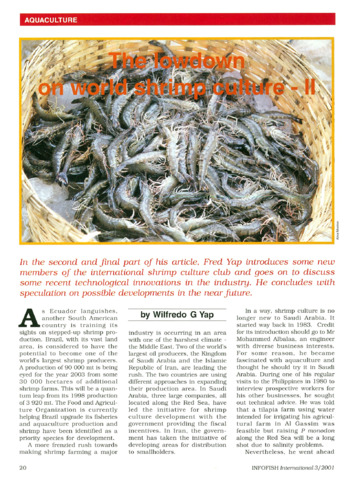A preliminary study on the effect of hypoxia on carotenoid metabolism in black tiger shrimp Penaeus monodon Fabricius
- Global styles
- MLA
- Vancouver
- Elsevier - Harvard
- APA
- Help

Date
1996Page views
5,718ASFA keyword
AGROVOC keyword
Taxonomic term
Metadata
Show full item record
Share
Abstract
The pigmentation of black tiger shrimp Penaeus monodon is due to astaxanthin, astaxanthin monoester, and astaxanthin diester. These carotenoids are biosynthesized from beta-carotene or zeaxanthin. Biosynthesis is postulated to be mediated by the enzymes C3 and C4 monooxygenase and caroten-4-ol dehydrogenase. Blue-shrimp syndrome, characterized by low total astaxanthin levels in shrimp epidermis, is associated with nutritional deficiency for carotenoids but other factors such as high organic matter, hypoxia, high density, and high pH may also be involved. In this study, the effect of hypoxia on carotenoid metabolism in P. monodon was investigated with respect to retention and transformation of carotenoids and the activity of the enzymes C3 and C4 monooxygenase and caroten-4-ol dehydrogenase.Two tanks were prepared each containing 25 pieces of shrimp fed a control diet (not containing any carotenoid) for two weeks. Shrimps in one tank (Treatment 1) were given beta-carotene supplemented diet (3.8 ppm) in the next two weeks while those in the other (treatment 2) were fed the control diet. Two days after introduction of the test diets, both treatments were subjected to hypoxia challenge (dissolved oxygen, 2.5-2.7 mg/L) and the carotenoid content and profile of feces monitored for succeeding days. Assay of enzyme activity was performed five days after hypoxia challenge. Results showed a ten-fold increase in fecal total carotenoid content of shrimps in treatment 2 (122.2 ppm) compared with that in treatment 1 (12.4 ppm) on hypoxia challenge and restores to basal level (3.9-4.1 ppm) after three days. The carotenoids found in the feces of shrimps in treatment 2 were astaxanthin, astaxanthin monoester, astaxanthin diesters, and an unidentified carotenoid which was also found in the muscle of stressed shrimp. Using beta-carotene as substrate, conversion to astaxanthin was not observed in the hepatopancreas homogenates of shrimps in both treatments. Instead, a slow conversion of astaxanthin to betacarotene (i.e., a reverse reaction) was noted in treatment 2 exhibiting twice the activity in treatment 1. Radiolabelling studies using 14C-labelled astaxanthin as substrate confirmed the existence of this enzyme-mediated reductive pathway from astaxanthin which occurs at a very slow rate. This study demonstrated the carotenoid-depleting effect of hypoxia on shrimp, both through enhanced fecal release and moderately elevated reductive pathway from astaxanthin. This effect suggests a possible mechanism by which blue-shrimp syndrome may develop.
Description
Abstract only
Type
Conference paperCollections
Related items
Showing items related by title, author, creator and subject.
-
An overview of the nutrition, feed and feeding techniques of prawn penaeid/shrimps
Piedad-Pascual, Felicitas (Philippine Council for Aquatic and Marine Research and Development, 1989)This paper echoes what transpired during the first International Conference of Penaeid Prawns/Shrimps held in Iloilo City in December 4-7, 1984, particularly on the Nutrition nd Feed Development. Around 25 papers were ... -
Series: Aquaculture extension manual; No. 19
Prawn hatchery operations
Parado-Estepa, Fe D.; Quinitio, Emilia T. ; Borlongan, Emeterio L. (Aquaculture Department, Southeast Asian Fisheries Development Center, 1996-05)
The manual, an updated version of the 1984 SEAFDEC/AQD manual, presents the underlying principles and step-by-step instructions of prawn larval and post-larval rearing. The techniques described are not only applicable to ...
; Borlongan, Emeterio L. (Aquaculture Department, Southeast Asian Fisheries Development Center, 1996-05)
The manual, an updated version of the 1984 SEAFDEC/AQD manual, presents the underlying principles and step-by-step instructions of prawn larval and post-larval rearing. The techniques described are not only applicable to ... -
The lowdown on world shrimp culture - II
Yap, Wilfredo G. (INFOFISH, 2001)This paper introduces some new members of the international shrimp culture club and goes on to discuss some recent technological innovations in the industry, particularly the polyculture of tilapia (mainly Oreochromis ...






